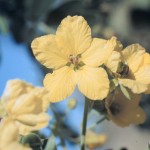Lindheimer Senna
Senna lindheimeriana
Fabaceae (Legume family)
Description
Lindheimer senna is an erect, perennial, foul-smelling legume with one to several velvety stems arising from a deep, woody root. Its compound leaves are hairy, spirally arranged and have five to eight pairs of oblong leaflets. The flowers, which have five yellow petals, are borne in upper leaf axils and are in spikes about as long as the leaves.
Habitat
This senna is found primarily in the Edwards Plateau, west through the Trans-Pecos and to Arizona and south into Mexico. It is common in shallow limestone soil, on hillsides and rocky ravines.
Toxic Agent
The compounds responsible for the toxicity of Senna are unknown. Lindheimer senna is very unpalatable and is consumed only in unusual circumstances. The plant has not been proven toxic by experimental feeding trials, but has been implicated in bovine deaths. In one case, cows from the Midwest were transported to the Hill Country and turned out in a small pasture containing a large amount of lindheimer senna. The hungry animals consumed a large amount of the plant, then displayed a clinical syndrome typical of coffee senna poisoning. Examined after death, they also had similar muscle lesions.
Signs of Livestock Ingestion
The clinical signs are those of animals with severe muscle damage and gastrointestinal disturbance and include: Diarrhea; Weakness; "Alert downers"-not depressed, will eat, but unable to rise; Dark urine; Death; Few animals that go down will recover.
Management Strategies
Poisoning can be prevented by not forcing cattle to consume these plants. Always fill animals new to an area with good forage before placing them in pastures where toxic plants are growing.
Images
Plant Characteristics
Flower Color: Yellow
Seed Type: Bean/Pod
Duration: Perennial
Stem Texture: Hairy
Growth Habit: Forbs/Broadleaf
Leaf Shape
 : Pinnately Compound
: Pinnately Compound
Season: Warm
Distribution
 : 02 - Gulf Prairies and Marshes, 04 - Blackland Prairies, 05 - Cross Timbers and Prairies, 06 - South Texas Plains, 07 - Edwards Plateau, 10 - Trans-Pecos
: 02 - Gulf Prairies and Marshes, 04 - Blackland Prairies, 05 - Cross Timbers and Prairies, 06 - South Texas Plains, 07 - Edwards Plateau, 10 - Trans-Pecos
Distributions
Distribution refers to the ecological region in Texas that a plant has been found. You can also view a clickable map.
Book: Toxic Plants of Texas (B-6105)
Collection: Toxics, Wild Flowers
Livestock Affected: Cattle, Goats, Horses, Sheep
Livestock Signs: Abnormal Urination, Collapse, Depression/ Weakness, Diarrhea, Incoordination






